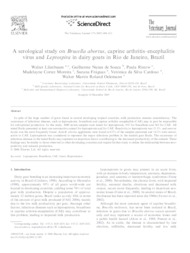A serological study on Brucella abortus, caprine arthritis-encephalitis virus and Leptospira in dairy goats in Rio de Janeiro, Brazil.
A serological study on Brucella abortus, caprine arthritis-encephalitis virus and Leptospira in dairy goats in Rio de Janeiro, Brazil.
Author(s): LILENBAUM, W.; SOUZA, G. N. de; RISTOW, P.; MOREIRA, M. C.; FRÁGUAS, S.; CARDOSO, V. da S.; OELEMANN, W. M. R.
Summary: In spite of the large number of goats found in several developing tropical countries, milk production remains unsatisfactory. The occurrence of infectious diseases, such as leptospirosis, brucellosis and caprine arthritis–encephalitis (CAE) may in part be responsible for sub-optimal production. In this study, 1000 serum samples were tested for leptospirosis, 953 for brucellosis and 562 for CAE. All tested flocks presented at least one seroreactive animal for leptospirosis and for CAE. Reactivity to leptospirosis was 11.1%, and serovar hardjo was the most frequently found. Anti-B. abortus agglutinins were found in 0.5% of the samples presented and 14.1% were seroreactive to CAE. Leptospirosis was considered to represent the major infectious problem in the studied goat flocks. The occurrence of infectious diseases in the tested flocks may represent an important factor contributing to the decreased productivity of the animals. These findings may be similar to those observed in other developing countries and require further study to define the relationship between seropositivity and reduced production.
Publication year: 2007
Types of publication: Journal article
Unit: Embrapa Dairy Cattle
Keywords: CAE, brucellosis, goats, leptospirosis, reproduction
Observation
Some of Embrapa's publications are published as ePub files. To read them, use or download one of the following free software options to your computer or mobile device. Android: Google Play Books; IOS: iBooks; Windows and Linux: Calibre.
Access other publications
Access the Agricultural Research Database (BDPA) to consult Embrapa's full library collection and records.
Visit Embrapa Bookstore to purchase books and other publications sold by Embrapa.

